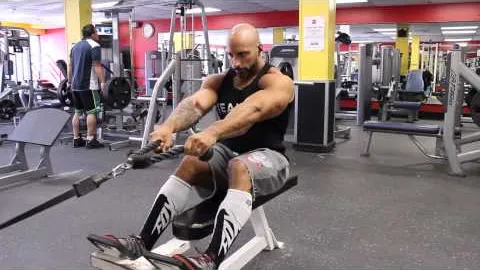
Low Cable Face Pull Exercise: Improve Posture and Strengthen Your Upper Back
The low cable face pull exercise is a great way to improve your posture and strengthen your upper back muscles. It targets the rear deltoids, rhomboids, and external rotators, helping to correct muscle imbalances caused by hunching over a desk or sitting for long periods. This exercise is also beneficial for athletes who want to enhance their performance by improving scapular stability and shoulder mobility.
Why Should You Incorporate the Low Cable Face Pull into Your Routine?
The modern lifestyle often involves prolonged sitting and repetitive movements like typing on a keyboard or using a smartphone. These activities can lead to rounded shoulders and a forward head posture, which can cause muscle imbalances and increase the risk of pain and injury.
The low cable face pull exercise specifically targets the upper back muscles that are often weak and overstretched due to poor posture. By incorporating this exercise into your routine, you can counteract the negative effects of prolonged sitting and promote a stronger, more stable upper back.
How to Perform the Low Cable Face Pull: Step-by-Step Guide
Stand facing a cable machine with the pulley set at chest height. Attach a rope handle to the cable.
Grab the rope handles with an overhand grip, palms facing down. Step back to create slight tension in the cable.
Position your feet shoulder-width apart, knees slightly bent. Maintain a tall posture with your chest up and shoulders pulled back.
Begin the movement by retracting your shoulder blades. Squeeze your shoulder blades together while keeping your elbows high.
Pull the rope towards your face, directing your hands towards your temples. Keep your elbows above shoulder height throughout the movement.
Pause for a moment when your hands reach your temples, then slowly reverse the movement, straightening your arms and returning to the starting position.
Repeat for the desired number of repetitions.
Tips for Proper Form and Safety
Variations and Progressions of the Low Cable Face Pull
Once you have mastered the basic low cable face pull, you can try different variations to target specific muscle groups or challenge your strength and stability further.
Narrow Grip Face Pull: Instead of using the rope handle, grasp the cable with a narrow, pronated grip (palms facing down). This variation shifts the focus onto the rear deltoids and provides a deeper contraction in the upper back muscles.
Single-Arm Face Pull: Perform the face pull one arm at a time by using a single handle attachment. This variation requires greater stability and control as you have to resist rotational forces.
Kneeling Face Pull: Lower the pulley to knee height and perform the exercise in a kneeling position. This variation increases the demand on your core and challenges your balance.
Banded Face Pull: Attach a resistance band to the cable handle and hold it with both hands. This variation adds additional resistance at the end range of motion, increasing the challenge on the targeted muscles.
Incorporating the Low Cable Face Pull into Your Workout Routine
To maximize the benefits of the low cable face pull exercise, it is recommended to include it in your upper body or back workout routine. Aim for 2-3 sets of 12-15 repetitions, focusing on maintaining proper form throughout the movement.
Combine the low cable face pull with other exercises that target the upper back and shoulder muscles to create a well-rounded training program. Some complementary exercises include bent-over rows, reverse flyes, and shoulder external rotations.
Remember to warm up before starting your workout to prepare your muscles and joints for the exercise. Spend a few minutes performing dynamic stretches and mobility exercises targeting the upper back, shoulders, and neck.
Conclusion
The low cable face pull exercise is a highly effective movement for improving posture and strengthening the upper back muscles. By regularly incorporating this exercise into your workout routine, you can correct muscle imbalances, reduce the risk of pain and injury, and enhance your athletic performance.
Focus on maintaining proper form, gradually increasing the resistance, and combining the low cable face pull with other exercises to optimize your training results. Remember to consult with a fitness professional if you have any underlying health conditions or concerns related to performing this exercise.
If you're looking for a gym, fitness club or yoga studio, you've come to the right place.
You can find information about gyms in your area. Browse catalog of gyms and find gyms with classes which are you looking for.
On gym page you can find simple information like address, phone or website. You can find list of available classes. You can check availability of personal training or small group classes. On place page you can also see information about open hours.
You can find gyms near you with amenities, courts, studios and equipments.
Use our map to find gym at your city or district.
In Gym Navigator you can find list of exercises with movies for many body parts.
You can browse exercises catalog and find exercises the best of you.
You can also find exercises grouped into workout plans, which you can use to improve you body. Each routine show you exercises one by one and give you possibility to count you progress and count down rest time.